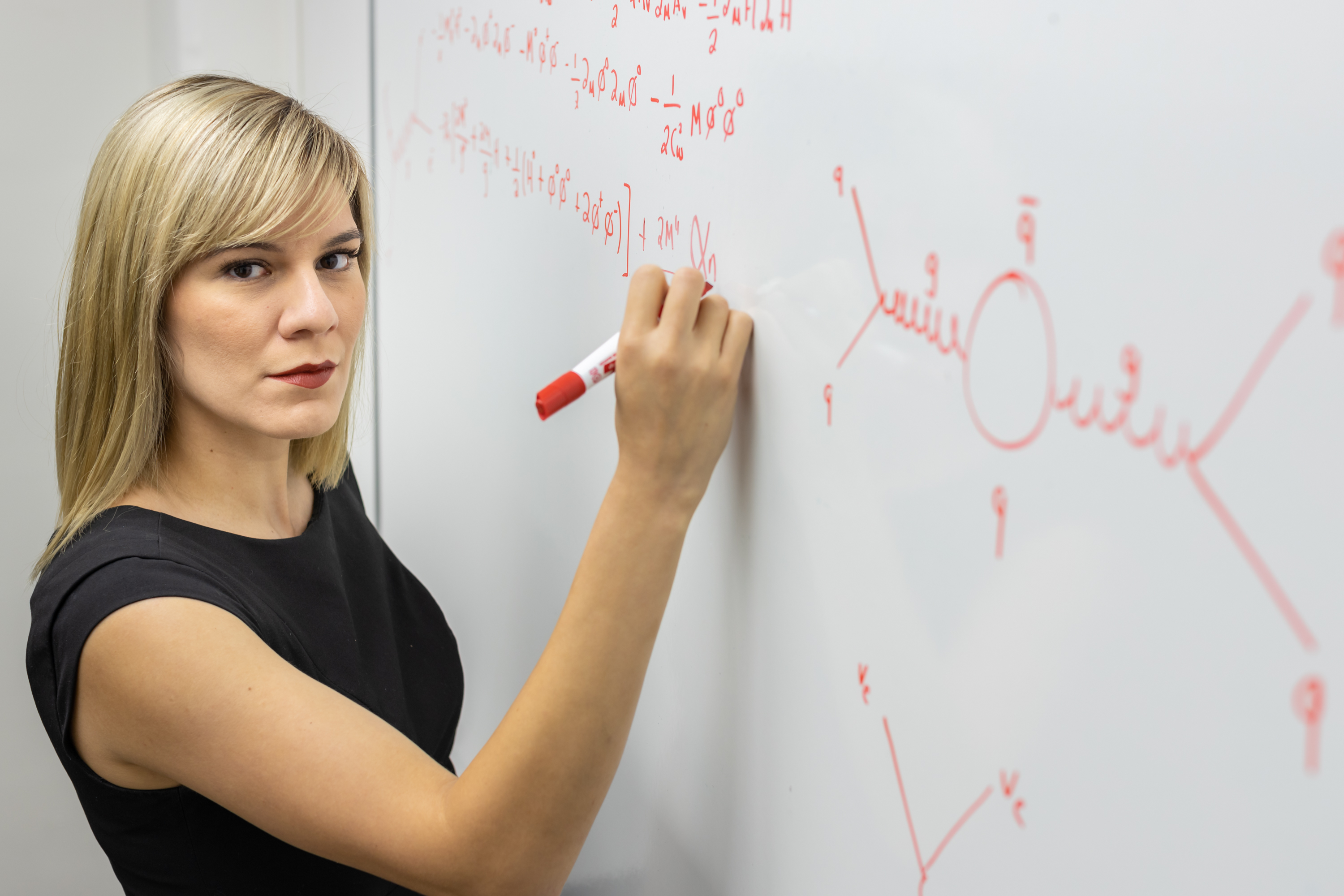But then, neither could anyone see the immediate impact of what Isaac Newton had found.
“When Newton discovered gravity, when the apple fell on his head, nobody knew that we were going to be able to study gravity and eventually build ships that could go up in outer space,” Delgado said. “And when the electron was discovered, nobody knew that we were going to use it for everything from electricity to anything related to magnetism. And the nuclear force also – it’s been more than 100 years that it was discovered and it only found applications in reactors fairly recently.”
Studying elementary particles small enough to need massive particle accelerators to detect them may have that kind of impact, she said. “You never know what the application is going to be. That’s why we do fundamental science.”
Delgado, a Eugene P. Wigner Fellow at the Department of Energy’s Oak Ridge National Laboratory, is using quantum computing to help investigate the fundamental building blocks of the universe and to see whether there are particles yet to be found. The Standard Model of the universe contains 17 fundamental particles, but scientists believe more exist, since the theory leaves several important unanswered questions.
“What is dark matter? Why do neutrinos have mass? How can we account for gravity? We don’t have a theory that incorporates all that,” Delgado said. “To account for all these things outside of the Standard Model, people like to propose ideas.”
And that’s what she is doing. Delgado works in the lab’s Physics Division under the Theoretical and Computational Physics group and is using her fellowship to apply quantum computing applications to study high energy physics. This research combines a scientific interest in extending knowledge of the fundamental building blocks of the universe and how they interact with each other and building better tools using quantum analysis to parse data from large-scale particle physics experiments, such as at the Large Hadron Collider, or LHC, at CERN in Switzerland.
But how did quantum computing get in the mix? It was rather serendipitous. When physicists began to take interest in quantum computing, Delgado arranged for a friend from Texas to give a talk about it to the ORNL physics community. Her friend invited her to a workshop of quantum computing users at the lab, where she met Travis Humble, director of the Quantum Science Center.
“I told him I was just there by chance, that I know nothing about quantum computing; I was working on high energy physics,” she said. “And it turned out he had a project on quantum computing applications to high energy physics, and he just invited me to work on that project. And that’s how it started. If my friend hadn’t dragged me to that workshop, who knows?”
It was, Delgado said, a quantum leap to join quantum computing and high energy physics. Quantum computing uses principles of quantum mechanics, which explains behavior of matter on the subatomic levels, using particles such as electrons or photons. It uses quantum bits, or qubits, that allow particles to exist in more than one state simultaneously, unlike traditional computers that use electrical impulses in a binary code. Quantum computing is less restrictive, and many areas of science are turning to it for insights into their fields. Using computers, Delgado analyzes data from the large physics experiments of the world to elucidate the universe.
“My research is looking to find an answer to the same question – what are the fundamental particles of the universe? – just using completely different methods,” she said. “I like the applications to high energy physics. Large-scale experiments need thousands of people, and you contribute a very small piece. Just having a quantum device to probe and look at these particles from another perspective and having a bigger impact was attractive to me. Trading a large experiment for table-top experiments, you get to probe the same properties.”
Delgado was not always interested in science. Originally from Ciudad Juarez, Chihuahua, Mexico – yes, she and her family have two Chihuahuas – she was interested in sociology, but did not enjoy the social science curriculum at her high school as it focused more on the business side of things. She leaned toward the science, technology, engineering and math fields and entered the University of Texas at El Paso majoring in physics and sociology. Her mother teaches math at UTEP, and her father is an architect.
After her first year of college, she spent the summer at Texas A&M University where the Cyclotron Institute offered undergraduate internships. That machine, a particle accelerator, speeds charged particles in a beam into a target to learn about atomic nuclei and to produce radioisotopes commonly used in medicine. That experience led Delgado to transfer there for her sophomore year and, ultimately, earn a doctorate in high energy physics.
Her dissertation research took her to CERN, home of the LHC, and the Fermi National Accelerator Laboratory, or Fermilab, another DOE national laboratory where the U.S. physicists’ CERN team is centered. Her doctoral work focused on proving or disproving the existence of a particle that is not contained in the Standard Model. Its existence would help alleviate some discrepancies observed at the time in results of CERN’s LHCb, or Large Hadron Collider beauty, experiment studying the beauty quark. The discrepancies seem to hint that the rate of the decay of B mesons to muons versus electrons is not the same, as one would expect in the context of the Standard Model. The analysis was performed on data collected by CERN’s Compact Muon Solenoid, or CMS, experiment, but in the end, Delgado was not able to detect its existence and ruled out the existence of a particle. Future theories can take advantage of that knowledge.
But that research left a bit of a gap in Delgado’s interests. At CERN and Fermilab, the experiments were conducted by teams of thousands of physicists. Incorporating the new field of quantum computing, however, offers her “the right balance of thinking about fundamental problems,” she said. “It’s like an intersection of science with philosophy. ”
Delgado came to Oak Ridge as a graduate research assistant in 2018 with her husband, Elvis Dominguez-Ontiveros, a nuclear engineer, who had taken a position at ORNL’s Spallation Neutron Source. Now they have two young children, Alice and Simon. Delgado’s ORNL mentor, neutrino researcher Alfredo Galindo-Uribarri, offered her an opportunity upon completion of her doctorate. ORNL gave her the breadth to do research with scientists of other fields. Still, she said, it can be a challenge to be interdisciplinary if one is only surrounded by physicists.
“At ORNL, I am able to work with people from math, computer science, engineering and other scientific fields. That has given me a different perspective and has definitely helped me advance my career,” she said.
When she arrived, she had two years left in her doctoral program. She commuted between Tennessee and Illinois, where Fermilab is located. She had been a National Science Foundation Graduate Research Fellow and a National GEM Fellow at Fermilab. Now a Wigner Fellow, she is able to carve a research path that was not available prior to coming to ORNL, she said, adding, “I am always looking to find people to collaborate.”
Outside of research, Delgado is devoted to her family. They enjoy the small town feel of Oak Ridge in eastern Tennessee. In her youth, she was a ballet dancer in her spare time; now she’s a suburban soccer mom, spending much of her time outside work driving her children to their activities. Still, “we really enjoy dancing at home when there is nothing on the schedule.” She tries to see her two sisters, one a nurse and the other a paralegal, in Texas, whenever she can.
As a Hispanic woman in science, Delgado is an advocate for diversity and inclusion and all that it offers. She participates in as many activities as possible that encourage girls’ interest in science. She chaired Women in Physical Sciences, a group supported by her directorate at the lab, to promote diversity and inclusion and provide personal and professional growth and development for members.
And if there are more fundamental particles in the universe to add to the Standard Model, she wants to be on the team that finds them.
ORNL’s Distinguished Staff Fellowship program aims to cultivate future scientific leaders by providing dedicated mentors, world-leading scientific resources and enriching research opportunities at a national laboratory. Fellowships are awarded to outstanding early-career scientists and engineers who demonstrate success within their academic, professional and technical areas. Fellowships are awarded for fundamental, experimental and computational sciences in a wide range of science areas.
UT-Battelle manages ORNL for the Department of Energy’s Office of Science, the single largest supporter of basic research in the physical sciences in the United States. The Office of Science is working to address some of the most pressing challenges of our time. For more information, please visit energy.gov/science. — Lawrence Bernard



